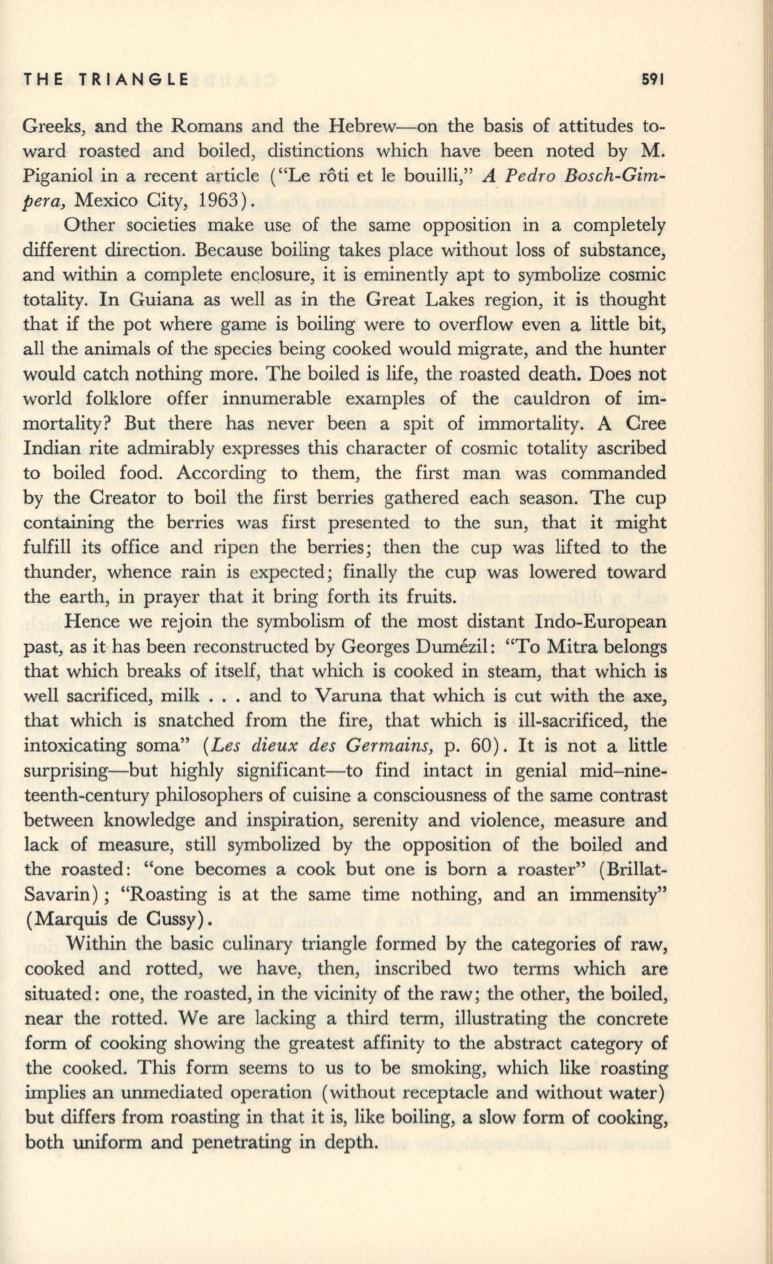
THE TRIANGLE
591
Greeks, and the Romans and the Hebrew-on the basis of attitudes to–
ward roasted and boiled, distinctions which have been noted by M.
Piganiol in a recent article ("Le roti et Ie bouilli,"
A Pedro Bosch-Gim–
pera,
Mexico City, 1963).
Other societies make use of the same opposition in a completely
different direction. Because boiling takes place without loss of substance,
and within a complete enclosure, it is eminently apt to symbolize cosmic
totality. In Guiana as well as in the Great Lakes region, it is thought
that if the pot where game is boiling were to overflow even a little bit,
all the animals of the species being cooked would migrate, and the hunter
would catch nothing more. The boiled is life, the roasted death. Does not
world folklore offer innumerable examples of the cauldron of im–
mortality? But there has never been a spit of immortality. A Cree
Indian rite admirably expresses this character of cosmic totality ascribed
to boiled food. According to them, the first man was commanded
by the Creator to boil the first berries gathered each season. The cup
containing the berries was first presented to the sun, that it -might
fulfill its office and ripen the berries; then the cup was lifted to the
thunder, whence rain is expected; finally the cup was lowered toward
the earth, in prayer that it bring forth its fruits.
Hence we rejoin the symbolism of the most distant Indo-European
past, as it has been reconstructed by Georges Dumezil: "To Mitra belongs
that which breaks of itself, that which is cooked
in
steam, that which is
well sacrificed, milk ... and to Varuna that which is cut with the axe,
that which is snatched from the fire, that which is ill-sacrificed, the
intoxicating soma"
(Les dieux des Germains,
p. 60). It is not a little
surprising-but highly significant-to find intact in genial mid-nine–
teenth-century philosophers of cuisine a consciousness of the same contrast
between knowledge and inspiration, serenity and violence, measure and
lack of measure, still symbolized by the opposition of the boiled and
the roasted: "one becomes a cook but one is born a roaster" (Brillat–
Savarin); "Roasting is at the same time nothing, and an immensity"
(Marquis de Cussy).
Within the basic culinary triangle formed by the categories of raw,
cooked and rotted, we have, then, inscribed two terms which are
situated: one, the roasted, in the vicinity of the raw; the other, the boiled,
near the rotted. We are lacking a third term, illustrating the concrete
form of cooking showing the greatest affinity to the abstract category of
the cooked. This form seems to us to be smoking, which like roasting
implies an unmediated operation (without receptacle and without water)
but differs from roasting in that it is, like boiling, a slow form of cooking,
both uniform and penetrating in depth.


